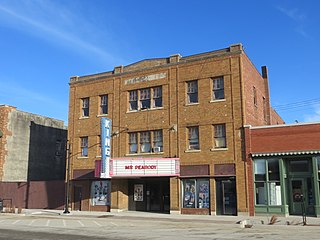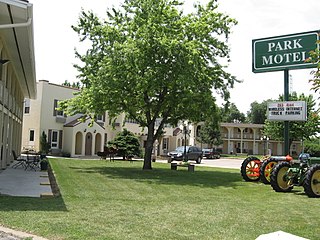
Council Bluffs is a city in and the county seat of Pottawattamie County, Iowa, United States. The city is the most populous in Southwest Iowa, and is a primary city of the Omaha-Council Bluffs Metropolitan Area. It is located on the east bank of the Missouri River, across from the city of Omaha, Nebraska. Council Bluffs was known, until at least 1853, as Kanesville. It was the historic starting point of the Mormon Trail. Kanesville is also the northernmost anchor town of the other emigrant trails, since there was a steam-powered boat to ferry their wagons, and cattle, across the Missouri River.

Seligman is a census-designated place (CDP) on the northern border of Yavapai County, in northwestern Arizona, the United States. The population was 456 at the 2000 census.

Belle Plaine is a city in Benton County, Iowa, United States. The population was 2,534 at the 2010 census. It is part of the Cedar Rapids Metropolitan Statistical Area.
U.S. Route 66, the historic east–west US highway between Chicago, Illinois and Santa Monica, California, passed through one brief segment in the southeastern corner of Kansas. It entered the state south of Baxter Springs and continued north until it crossed the Brush Creek, from where it turned east and left the state in Galena. After the decertification of the highway in 1985, this road segment was numbered as US-69 (alternate) from Quapaw, Oklahoma north to Riverton, Kansas and as K-66 from Riverton east to Route 66 in Missouri.
U.S. Route 66 is a former east–west United States Numbered Highway, running from Santa Monica, California to Chicago, Illinois. In Missouri, the highway ran from downtown St. Louis at the Mississippi River to the Kansas state line west of Joplin. The highway was originally Route 14 from St. Louis to Joplin and Route 1F from Joplin to Kansas. It underwent two major realignments and several lesser realignments in the cities of St. Louis, Springfield, and Joplin. Current highways covering several miles of the former highway include Route 100, Route 366, Route 266, Route 96, and Route 66. Interstate 44 (I-44) approximates much of US 66 between St. Louis and Springfield.

The Minne Lusa Residential Historic District is located in North Omaha, Nebraska. It is included on the National Register of Historic Places. According to the National Park Service, it is an "example of a substantial, affordable single-family residential development within the city limits that was platted, developed and constructed by a single firm between 1915 and 1941." The neighborhood is filled with bungalows, Craftsman, and other styles that were popular in the era. There are 540 properties in the neighborhood that contribute to the historic district, the other 167 do not. Minne Lusa Boulevard is a contributing structure.

Belvidere Café, Motel and Gas Station is a historic building in Litchfield, Illinois along Route 66. The site also has a residence and two motel units.

The Park Motel is a historic building located in Denison, Iowa, United States. It is an example of a well-preserved highway motel during the early age of motoring. It appears this is also an early example of a motel in Iowa and may be one of the earliest in the Midwest.

The Houghton County Traction Company Ahmeek Streetcar Station is a rail station located at the corner of US 41/M-26 and Hubbell Street in Ahmeek, Michigan. It was listed on the National Register of Historic Places in 2000.

The Crescent Warehouse Historic District is a 10.5-acre (4.2 ha) historic district in Downtown Davenport, Iowa, United States. The district is a collection of multi-story brick structures that formerly housed warehouses and factories. Most of the buildings have been converted into loft apartments. The district was listed on the National Register of Historic Places in 2003.

The Middlesex Plat Historic District is located in Des Moines, Iowa, United States. It was an upper-middle-class neighborhood of two-story square houses and bungalows that were built from 1910 to 1923. The district has been listed on the National Register of Historic Places since 2000. It is part of The Bungalow and Square House--Des Moines Residential Growth and Development MPS.

The Sixth and Forest Historic District is located in Des Moines, Iowa, United States. It is a Victorian era suburban commercial district on the northeastern and northwestern corners of the junction of 6th and Forest Avenues, and originally contained six buildings. The buildings on the northeast corner have subsequently been torn down. The historic district has been listed on the National Register of Historic Places since 1996. It is a part of the Towards a Greater Des Moines MPS.

The Sankot Motor Company, also known as the Sankot Garage, is a historic building located in Belle Plaine, Iowa, United States. The historical significance of this building is its association with the increase in all-season travel and the development of businesses to serve them along the Lincoln Highway, the United States's first transcontinental route. It is a brick front building with side walls of clay tile that was constructed on a concrete foundation. The west half of the building was added in 1927. It was operated by O.B. Charles and Sid Sankot until 1937. They also sold Chryslers. Gasoline was sold from 1920 to 1944. F.L. Sankot bought the business in 1937. In addition to vehicle repair he sold Case and Oliver tractors and implements. William and Jerry Sankot purchased the business in 1985, and limited it to passenger, commercial and agricultural vehicle repairs. The building was listed on the National Register of Historic Places in 1995. It was included as a contributing property in the Belle Plaine Main Street Historic District in 2013.

The Herring Hotel, also known as the Herring Cottage, The Herring, Hotel Herring, The Graham House Hotel, is a historic building located in Belle Plaine, Iowa, United States. Built in 1900, the American Craftsman style frame building replaced an earlier hotel with the same name that had been destroyed in a massive fire that destroyed most of the central business district in 1894. Will Herring built his namesake hotel and he had owned the previous hotel, which had been built by his father-in-law William Blossom as the Tremont House. The building was designed by Cedar Rapids architect Charles A. Dieman, and constructed by local contractor James Park.

The Frank E. and Katie (Cherveny) Zalesky House is a historic building located in Belle Plaine, Iowa, United States. Built around 1872, the 2½-story, brick house features a mansard roof with dormers, roof cresting, veranda-like porch, bracketed cornice, a two-story bay, and windows with heavy hoods. The Zalesky family were part of Belle Plaine's Bohemian immigrant community. That community included author, philosopher, teacher and journalist František Klácel who lived in this house at the end of his life under the Zalesky's care. The house was listed on the National Register of Historic Places in 2012.

The Belle Plaine Main Street Historic District is a nationally recognized historic district located in Belle Plaine, Iowa, United States. It was listed on the National Register of Historic Places in 2013. At the time of its nomination it contained 63 resources, which included 46 contributing buildings, one contributing structure, and 16 non-contributing buildings. The historic district covers most of the city's central business district. Belle Plaine was laid out in 1862 as a railroad town. The Chicago & North Western Railroad was extended from Cedar Rapids the following year. The commercial district is adjacent to the tracks. A major fire destroyed much of the business district in 1894. Thirty-five buildings in the district were built in the months after the fire.

The William and Sue Damour House is a historic house located at 1844 Second Avenue SE in Cedar Rapids, Iowa.

The Cedar Rapids 2nd Avenue SE. Automobile Row Historic District is a nationally recognized historic district located in Cedar Rapids, Iowa, United States. It was listed on the National Register of Historic Places in 2015. At the time of its nomination it consisted of 24 resources, which included 17 contributing buildings, two contributing sites, four non-contributing buildings, and one non-contributing structure. This is a collection of commercial buildings that were built along the old Lincoln Highway between 1912 and 1953 to house automobile dealerships. They feature broad fronts with large display windows and open interiors. Auto repair shops were generally located at the rear of a dealership, but some were located in their own utilitarian buildings. Some of the corner lots were taken up by small gas stations. In later years, sales lots were placed adjacent to dealerships in order to display a larger number of cars. Other lots were occupied by used car lots. Prior to being converted into an automobile-centric commercial area, the district was a Victorian-era residential neighborhood. The multi-family dwelling at 309 8th St. SE remains as a reminder of that era, and it is one of the contributing properties.

The King Tower Historic District, also known as The King Tower One-Stop, is a historic district located in Tama, Iowa, United States. It was listed on the National Register of Historic Places in 2020. The King Tower One-Stop is a gas station, tourist court, and cafe built by Wes Mansfield on the Lincoln Highway. The Spanish Colonial Revival gas station and cafe was completed in 1937, and 18 tourist cabins were completed the following year. The historic district is an example of a "one stop-food, gas, auto repair and tourist cabins" that were built during "the transition from mom-and-pop roadside businesses to the national chain gas, food and lodging businesses that would soon dominate the trade." At one time it was open 24-hours-a-day, seven-days-a-week. In addition to over-the-road truckers, travelers, law enforcement officers, and local families, it was a place the town's bar patrons would go after the bars closed at 2:00 am. Local clubs and organizations held their meetings here. It was also a stopping point for presidential hopefuls before the Iowa caucuses.


















